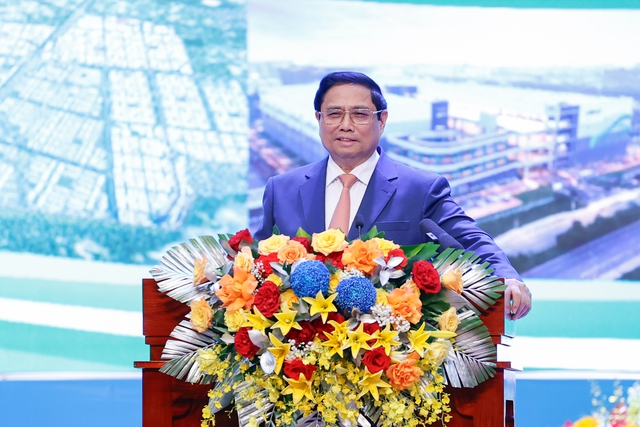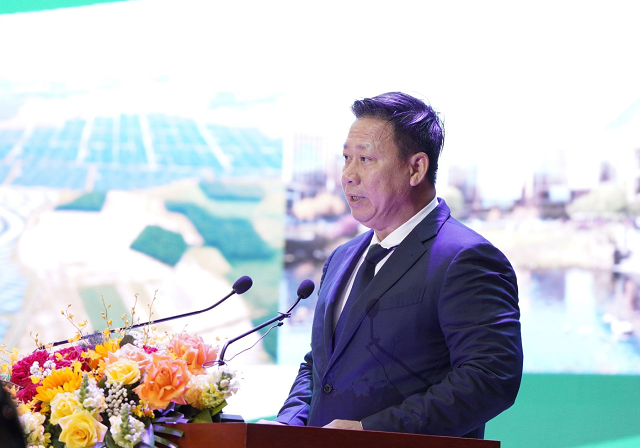Western Ninh Province’s Planning for 2030

Prime Minister Pham Minh Chính speaks at the conference. Photo: VGP
|
On May 5th afternoon, the People’s Committee of Tay Ninh province held a conference to announce the planning for Tay Ninh province for the period 2021-2030, with a vision to 2050.
Tay Ninh Takes Industry and Tourism Services as Driving Forces
According to Mr. Nguyen Thanh Ngoc, Chairman of the People’s Committee of Tay Ninh province, the province’s planning is based on inheriting and promoting the development orientations of the province through different periods. With the goal that by 2030, the province’s socio-economic development will be rapid, comprehensive, and sustainable, becoming one of the centers of industry and tourism services in the Southeast region and the whole country.
By 2050, Tay Ninh will have an effective public administration system, a friendly business environment, and an attractive living environment based on a sustainable and diverse ecosystem. Tay Ninh takes industry and tourism services as the main drivers for growth associated with the development of new space. Agriculture will develop in the direction of value chain, quality, and efficiency.
Technical infrastructure, social infrastructure, and urban areas will be invested synchronously, modernly, and civilized; science, technology, and knowledge economy will be strongly promoted; education, health care, culture, and social development will be comprehensively developed; national defense will be maintained, political security, and social order and safety will be ensured.

Chairman of the provincial People’s Committee Nguyen Thanh Ngoc speaks at the conference announcing the province’s planning
|
The province has set out 7 strategic breakthroughs, including: breakthrough in infrastructure development; developing human resources; institutional reform; development of small and medium enterprises; sustainable development: Green Tay Ninh; tourism development; and service economy development.
The provincial planning with the plan to organize socio-economic activities in 3 development regions, 4 dynamic axes, 1 social security belt.
The development zones include: Zone 1: Trang Bang town, Go Dau district, and part of the southern area of Duong Minh Chau district is an industrial and urban service development zone.
Zone 2: Tay Ninh City, Hoa Thanh town, the western area of Duong Minh Chau district, and part of the eastern area of Chau Thanh district are the administrative, cultural, educational, medical, and tourism centers, taking services as the main focus, followed by supporting industry and processing, technology agriculture.
Zone 3: Tan Bien district, Tan Chau district, the west of Chau Thanh district, and the north of Ben Cau district are agricultural development zones, gradually developing services towards social security and eco-tourism in the areas of Lo Go – Xa Mat, Hoa Hoi forest, and the Vam Co Dong river.
The 4 dynamic axes include: Axis 1 with the Go Dau – Xa Mat expressway and National Highways 22, 22B, is the province’s main North – South development corridor. Axis 2 is associated with the Ho Chi Minh road and National Highway 22, a corridor linking the province with Binh Duong and Cambodia in the East – West direction for the southern region, connecting with National Highway 13, National Highway 14 to Long Thanh airport.
Axis 3 is associated with the Dat Set – Ben Cui – Ben Cau route, which is a belt route for transferring goods between the Ben Cui, Thanh Duc industrial zones, the Moc Bai border economic zone to Cambodia, connecting with Ho Chi Minh City through junctions with the Ho Chi Minh City – Moc Bai expressway, Go Dau – Xa Mat expressway and connecting to the East to Binh Duong and the Central Highlands.
Axis 4 is associated with Provincial Road 781, which is a corridor linking provinces with Binh Duong and Cambodia in the East – West direction for the central region.
The social security belt is associated with the expressway along the border, connecting the region with the Mekong River Delta through Long An and the Central Highlands through Binh Phuoc, which is a corridor supporting national defense – security and social security for the northern region.
Regarding the plan to develop the urban system by 2030, the province strives to have 16 urban areas: 1 type II urban area (Tay Ninh City); 3 type III urban areas (Trang Bang, Hoa Thanh, Go Dau); 5 type IV urban areas (Tan Chau, Tan Bien, Chau Thanh, 2 new urban areas Ben Cau, Duong Minh Chau), and 7 new type V urban areas in Tan Bien district, Tan Dong, Tan Hung in Tan Chau district, and Thai Binh, Thanh Dien in Chau Thanh district.
Tay Ninh Enjoys “Favorable Conditions, Location, and People”
Speaking at the conference, Prime Minister Pham Minh Chinh basically agreed with the content of the conference; expressed his impression with the aspiration, will, and determination of the provincial Party Committee, government, military, and people of Tay Ninh in the periods and in building and implementing the plan; analyzed and emphasized some key contents.
According to the Prime Minister, Tay Ninh has many potentials and advantages. Tay Ninh belongs to the Southeast region, an economic region, a locomotive of the country’s economy; is a border province with an important geo-political position in terms of national defense, security, and foreign affairs, is the “fence” in the southwest of the country; plays a role in connecting provinces in the Central Highlands with the Southeast, connecting the Mekong River Delta with the Southeast and the East-West Economic Corridor.
Tay Ninh has great potential to develop the border economy, especially when trade with Cambodia is increasing very rapidly, is a direct and indirect connection point with a number of Southeast Asian countries. Tay Ninh has all three factors “favorable conditions, location, and people” to accelerate rapid and sustainable development.








































